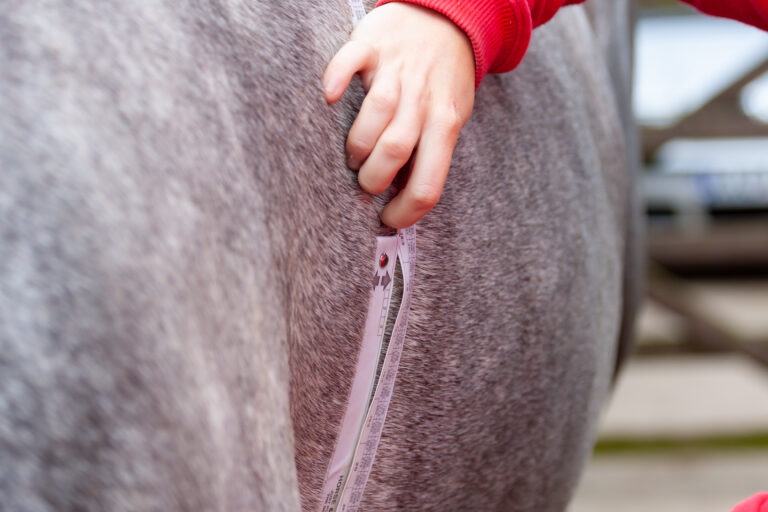
In this episode of the Disease Du Jour podcast, Isabelle Kilcoyne, DVM, DACVS, joined us to discuss regional limb perfusions. She talked about clinical applications, antibiotic selection, her recommended techniques, and more.
What Is Regional Limb Perfusion?
Regional limb perfusion is a technique for treating equine limb infections. It involves isolating the horse’s limb from systemic circulation by placing a tourniquet and then administering a high concentration of antibiotics to that portion of the limb. The tourniquet should stay in place for 20-30 minutes to allow the antibiotics to diffuse into the soft tissues, bone, and novel structures of the limb, which should result in a higher antibiotic concentration than with systemic administration.
Clinical Applications for Regional Limb Perfusion
Regional limb perfusion is commonly used to treat orthopedic infections of the distal limb, where horses have very limited soft tissue coverage. It can also be used in horses undergoing orthopedic fracture repair.
“Particularly if they’ve been open fractured, they have a much higher rate of ending up with an infection afterward,” Kilcoyne said. “But even with more elective fracture repairs or arthrosis, we’ll sometimes prophylactically do regional limb perfusions on those horses to increase concentrations of antibiotics prior to the procedure and to hopefully prevent any infections afterward.”
Another application for regional limb perfusions is after a nail has punctured the bottom of the hoof. Overall, the procedure can be used to treat “basically any infection or septic process that’s going on in the distal limb,” she said.
Antibiotic Selection for Regional Limb Perfusion
Kilcoyne said she typically uses amikacin when performing regional limb perfusions for a couple of reasons. First, it’s a concentration-dependent antibiotic, so it doesn’t have to be administered as frequently as time-dependent antibiotics such as penicillin. Second, the most common bacteria associated with wounds are staphylococcal and enteric species, and amikacin has a good spectrum of coverage for both Gram-negative aerobes and Staphylococcus.
“We may alter what antibiotic we’re using depending on the culture and sensitivity results,” said Kilcoyne, mentioning she sometimes reaches for a third-generation Cephalosporin based on test results.
Tips for Performing Regional Limb Perfusions
Kilcoyne then shared some of her tips and tricks for performing effective regional limb perfusions. One piece of advice she offered is to be ready to perform the procedure three to four minutes after sedating the horse so you’re not on the tail end of the sedation. “That helps prevent them moving too much if they’re well-sedated for the whole 20 minutes that I leave the tourniquet on,” she said.
She also noted that tourniquet placement is very important. “Particularly in the front limb, if you’re using your cephalic vein, it tends to live in that little groove, so you always want to be careful that your tourniquet is actually occluding it,” she said. She typically uses some gauze underneath the tourniquet to make sure she’s getting sufficient pressure to occlude the vessel, and then she places the tourniquet as tight as possible.
Kilcoyne prefers an over-the-needle catheter rather than a butterfly catheter. “Because in a hospital setting I tend to be doing the procedure more frequently, like every day for a few days, it kind of preserves the vein a little bit,” she said. “And I feel like once the catheter is in, they stay in a little bit better than the butterflies that tend to be a bit more flimsy.”
Listen to the full episode for more tips on performing regional limb perfusions.
Potential Complications
Kilcoyne said regional limb perfusions are typically benign. One potential complication is hematoma formation, which can happen if the catheter moves.
Some horses develop phlebitis associated with the catheter insertion site, especially if you’re repeating the procedure multiple times over the course of a few days. “Usually, if you’re just doing one or two, we tend to not see so much of a problem,” she said.
Kilcoyne has seen a few horses develop regional cellulitis, but this typically happens in the winter when horses are muddier. She said while you don’t necessarily need to perform a full sterile preparation, getting the horse as clean as possible can help prevent this complication.
About Dr. Isabelle Kilcoyne
Isabelle Kilcoyne, DVM, DACVS, graduated from the University College Dublin in 2008 where she spent a year as an Equine Surgical intern at the University Veterinary Hospital. She then joined the Equine Field Service team at UC Davis for two years, after which she completed an Equine Surgery residency at the UC Davis Veterinary Medical Teaching Hospital.
She obtained board certification with the American College of Veterinary Surgeons in 2015 and is currently working as an Associate Professor in Equine Emergency and Critical Care at UC Davis.
Her main clinical and research interests involve advances in the diagnostics and management of colic and treatment of orthopedic infections and wounds.
Related Reading
- Mastering Regional Limb Perfusions in Horses
- Chlorhexidine Flush: Potential Treatment for Septic Arthritis in Horses?
- Strategies for Equine Bandaging and Splinting Success
Stay in the know! Sign up for EquiManagement’s FREE weekly newsletters to get the latest equine research, disease alerts, and vet practice updates delivered straight to your inbox.




